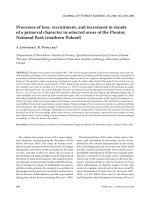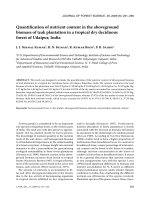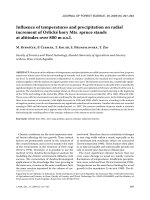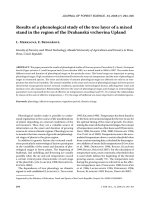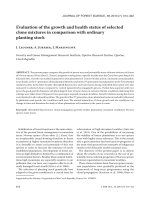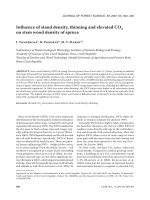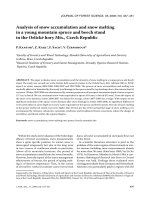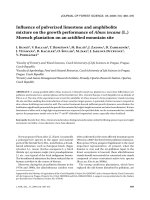Báo cáo lâm nghiệp: " Influence of a planting hole application of dolomitic limestone powder and basalt grit on the growth of Carpathian birch (Betula carpatica W. et K.) and soil chemistry in the air-polluted Jizerské hory Mts." pptx
Bạn đang xem bản rút gọn của tài liệu. Xem và tải ngay bản đầy đủ của tài liệu tại đây (261.52 KB, 11 trang )
J. FOR. SCI., 53, 2007 (11): 505–515 505
JOURNAL OF FOREST SCIENCE, 53, 2007 (11): 505–515
Supported by the Foundation for Rescue and Restoration of the Jizera Mountains, Project No. 070108, Internal Grant Agency
of the Faculty of Forestry and Environment, Project No. 3103, the Ministry of Environment of the Czech Republic, Project
No. MZP VaV-SM/2/28/04, and the Ministry of Agriculture of the Czech Republic, Project No. MZe 0002070201.
Influence of a planting hole application of dolomitic
limestone powder and basalt grit on the growth
of Carpathian birch (Betula carpatica W. et K.)
and soil chemistry in the air-polluted Jizerské hory Mts.
I. K
1
, V. B
2
, D. Z
1
1
Faculty of Forestry, Wildlife and Wood Sciences, Czech University of Life Sciences Prague,
Prague, Czech Republic
2
Forestry and Game Management Research Institute, Opočno Research Station, Opočno,
Czech Republic
ABSTRACT: e objective of the study was to evaluate the growth potential of Carpathian birch (Betula carpatica W.
et K.) at an environmentally harsh mountain site and a response of this species to altered soil chemistry after dolomitic
limestone and basalt grit applications. e Carpathian birch proved to be a suitable species for the replanting of extreme
acidic mountain sites. is birch shows a low mortality rate, grows well in the clear-felled patches and soon forms a
cover which is necessary for the reintroducing of more sensitive tree species. e application of dolomitic limestone and
basalt grit resulted in the slower growth of Carpathian birch plantations. Liming raised soil reaction, sum of exchange-
able bases, base saturation, cation exchange capacity and reduced exchangeable Al content. On the other hand, liming
decreased an amount of oxidizable soil organic matter and negatively affected soil N, exchangeable P and K. Basalt grit
increased exchangeable P and K contents and raised soil reaction, however only slightly. e influence of basalt grit on
the sum of exchangeable bases, base saturation and cation exchange capacity was also less pronounced compared to
liming. Basalt grit elevated the proportion of exchangeable aluminium and reduced the content of soil N.
Keywords: Carpathian birch (Betula carpatica W. et K.); Jizerské hory Mts.; chemical amelioration; liming; basalt grit;
forest soils; acidic deposition; forest ecosystems
Forest ecosystems in the Jizerské hory Mts.
(Northern Bohemia) were heavily affected by air
pollution stress followed by tortrix (Zeiraphera
griseana Hbn.) and bark beetle (Ips ssp.) outbreaks
(V et al. 2003). erefore, large areas of forest
stands had to be cut down in the 1980s. In terms
of air pollution, the situation improved substan-
tially in the 1990s, however, it is still very difficult
to replant the clear-felled patches mainly because of
their harsh microclimate. Carpathian birch (Betula
carpatica W. et K.) as an autochthonous pioneer
species might play an important role in the process
of restoration of forests damaged or destroyed by
air pollution.
Despite some morphological and taxonomic prob-
lems regarding Carpathian birch (Ú et
al. 2001), this taxon is prevailingly considered as a
narrowly defined species in recent Czech literature
(K 1990; K 2002). ere is however a lack
of detailed information regarding the ecological
requirements of this species that naturally occurs
in the Central European mountains on poor acidic
soils. To counteract the process of soil acidification
caused by deposition of air pollutants, liming and
506 J. FOR. SCI., 53, 2007 (11): 505–515
application of basic amendments is used in some
cases. e objective of this study is to evaluate the
response of Carpathian birch, which presumably
requires an acidic soil environment, to precisely ap-
plied dolomitic limestone and basalt grit.
MATERIALS AND METHODS
The planting experiment was installed in the
framework of the Jizerka Field Experiment man-
aged by the Opočno Research Station (Forestry and
Game Management Research Institute in Jíloviště-
Strnady) on the Central Ridge of the Jizerské hory
Mts. (Střední Jizerský hřeben – latitude 50°49´N,
longitude 15°21´E, Northern Bohemia) at an altitude
of 980 m. e experimental plantation is located on
a large clear-felled patch on the summit of the ridge.
e mean annual air temperature (1996–2003) at
the site is 4.9°C and the mean annual precipitation
(1994–2003) is 1,089 mm (B in S et
al. 2005). e bedrock is biotitic granite. e soil
was determined as a transition form from mountain
humus podzol to peat podzol (Umbri Placic Podzol
according to the FAO terminology). Stratification:
L (0–2 cm), F (2–8 cm), H (8–12 cm), Ah (12–13 cm),
Ep (13–17 cm), B (17+ cm). e average air SO
2
and
fluorine concentration is 11 µg/m
3
and 0.18 µg/m
3
.
e trees were planted on a game-proof fenced
plot in the spring of 1993. e experimental planta-
tion consists of Carpathian birch (Betula carpatica
W. et K.) trees which originate from the Jizerské hory
Mts. A 1-year-old bare-rooted planting stock was
used. A block of 7 subplots was established. Each
subplot (10 × 10 m) contained 50 trees at the spac-
ing of 1 × 2 m at that time. In addition to the control
variant (3 subplots), two alternative variants were
established: the “limestone variant” (2 subplots) and
the “basalt variant” (2 subplots).
In the limestone variant, 1 kg of the dolomitic
limestone powder was incorporated into the soil
within the space of planting holes (35 × 35 × 25 cm)
per each tree at planting. It means that 50 kg of the
amendment were used per 100 m
2
.
In the basalt variant, the basalt grit was incorpo-
rated into the soil inside the planting holes. 2 kg of
basalt grit per tree were used in an effort to achieve
a sufficient acidity neutralizing effect.
e dolomitic limestone from the Horní Lánov
quarry (Northern Bohemia) was used. is amend-
ment contained 21.5% of Ca and 11.3% of Mg. In
terms of particle-size distribution, the limestone
powder consisted of 5.8% of particles over 1 mm
in diameter, 16.3% of particles between 1.0 and
0.5 mm in diameter, 20.4% of particles between
0.5 and 0.2 mm in diameter and 57.2% of particles
below 0.2 mm in diameter.
e applied basalt grit originated from the Nové
Město pod Smrkem quarry (Northern Bohemia). e
material contained 8.6% of Ca, 6.1% of Mg, 0.96%
of K and 0.41% of P. In this amendment, there were
60% of particles larger than 1 mm in diameter, 19%
of particles 0.5–1 mm, 13% of particles 0.5–0.2 mm
in diameter and 8% of particles smaller than 0.2 mm.
e particle size distribution of the applied basalt
material is not optimal. e material was, however,
a waste of a local quarry and there was a request for
its testing as a cheap environmentally-friendly basic
amendment at that time.
A scaled rod was used to measure tree height and
crown diameter. e tree heights were measured to
the nearest 1 cm and crown diameter to the nearest
10 cm. A calliper was used to measure the stem base
diameter to the nearest ± 1 mm.
e nutrition analyses are presented in percentages
of macroelements (N, P, K, Ca, Mg, S) in dry matter
of assimilatory (leaf) tissues. e nutrition status of
assimilatory tissues was determined in 1993, 1994,
1995, 1996, 1999, 2000, 2001, 2003 and 2004. A com-
posite sample of leaves from each variant was taken
around the turn of August and September, when the
aboveground parts of the trees had finished their ac-
tive growth. e healthy fully developed leaves were
pooled in the samples.
Soil samples were taken in September 2002. Two
composites for each variant were formed: the 0 to
10 cm composite and the 10–20 cm composite. is
limited number of composites per variant was taken
in order to avoid damage to the roots of the tested
trees because the soil was sampled directly from
the space-limited planting holes densely colonized
by roots.
e composites were formed so that approximately
15 to 20 cores were taken within a particular treat-
ment variant. A core is considered as a subsample of
soil taken with a soil corer (3 cm in diameter) from
the space of a planting hole. Since most feeder roots
are located in the surface layer (0 to 20 cm), the soil
samples were collected from this zone. e L-horizon
was removed from the cores because it was usually
integrated into the sod layer of grass. Each core was
then divided into a 0–10 cm part and 10–20 cm part.
e separated parts were pooled into the 0–10 cm and
10–20 cm composites within a particular variant. is
approach of pooling small cores into bulk composites
does not facilitate a statistical analysis. ough, the
achieved information seems to be highly relevant.
The following chemical properties of the fine
homogenized earth of the composites were deter-
J. FOR. SCI., 53, 2007 (11): 505–515 507
mined: pH in water and 1N KCl, characteristics of
soil adsorption complex (SEB – sum of exchangeable
bases, CEC – cation exchange capacity, BS – base
saturation) according to Kappen’s procedures, fur-
ther the oxidizable organic matter (Springer-Klee),
soil nitrogen content (Kjeldahl’s method) and ex-
changeable nutrients extracted with 1% solution of
citric acid. e plant available P was determined by
the Spekol 210 apparatus, plant available Ca and Mg
by AAS (Atomic Absorption Spectroscopy).
e samples of assimilatory tissues and soil sam-
ples were analyzed at the Tomáš Laboratory using
the procedures described by Z (1994, 1995,
1996).
Height increment, stem base diameter and crown
diameter were statistically analyzed using the
Kruskal-Wallis analysis and multiple comparisons.
e mortality rates were assessed by means of a bi-
nomial test with subsequent multiple comparisons.
Trends in the nutrition of plantations were evaluated
using the linear-regression lines smoothing the mac-
roelement concentrations recorded within a variant
in the years of sampling. For each macroelement
and variant, the existence of a significant divergence
of the time axis and regression line representing a
development in macroelement concentration was
examined. For each macroelement, a mutual paral-
lelism of regression lines representing the compared
variants was also tested. A partial correlation test
was used to examine a relationship between devel-
opments of height increment and concentrations of
foliar macroelements. e methods are described
by A (1998). e confidence level of 95% was
chosen in all the statistical tests. As it is explained
in the text above, the outcomes of soil analyses were
not statistically tested. e statistically processed
files of the mensurational characteristics consist of
the data only that are related to the trees surviving in
the autumn of 2004, the data belonging to the dead
trees were retrospectively excluded.
RESULTS
Mortality
e mortality of Carpathian birch was relatively
low (Table 1). e highest annual mortality rates
were registered in the first half of the studied period
Table 1. Development of total mortality (T.M.) and annual mortality (A.M.) in the particular treatment variants
Variant 1993 1994 1995 1996 1997 1998 1999 2000 2001 2002 2003 2004
Control
T.M. (%) 0.0 3.4 7.4 10.7 11.4 12.8 12.8 13.4 14.1 14.1 14.8 14.8
A.M. (%) 0.0 3.4 4.0 3.4 0.7 1.3 0.0 0.7 0.7 0.0 0.7 0.0
Limestone
T.M. (%) 0.0 1.0 1.0 1.0 3.1 3.1 3.1 3.1 4.1 4.1 4.1 4.1
A.M. (%) 0.0 1.0 0.0 0.0 2.1 0.0 0.0 0.0 1.0 0.0 0.0 0.0
Basalt
T.M. (%) 0.0 0.0 2.1 4.1 8.2 8.2 10.3 11.3 12.4 12.4 13.4 13.4
A.M. (%) 0.0 0.0 2.1 2.1 4.1 0.0 2.1 1.0 1.0 0.0 1.0 0.0
0
25
50
75
100
125
150
175
200
225
Control Limestone Basalt
Variant
(cm)
i04
i03
i02
i01
i00
i99
i98
i97
i96
i95
i94
i93
h02
Fig. 1. Average plantation height as regis-
tered in the particular treatment variants
in 2004
h92
508 J. FOR. SCI., 53, 2007 (11): 505–515
and then decreased. Since 1998 onwards, the an-
nual mortality rates did not exceed 2.1% in any of
the compared treatment variants. e lowest total
mortality (2004) of 4.1% was recorded in the lime-
stone treatment. e total mortality rates (2004) in
the control and basalt treatment were higher and
reached 14.8% and 13.4%, respectively. A significant
overall heterogeneity in total mortality rates (2004)
was detected (p-value = 0.03). e subsequent mul-
tiple comparisons, however, did not define any pair
of variants, wherein the total mortality rates (2004)
significantly differed.
Height growth
e basalt and limestone treatments inhibited the
height increment of the birch trees. e superiority
of control variant in the height growth of trees is
apparent in Fig. 1, which depicts the average planta-
tion height in the particular treatment variants in
2004 (Table 2).
Table 3 summarizes the annual height incre-
ments since planting and the periodic annual incre-
ment P.A.I. (1993–2004). An overall p-value of the
Kruskal-Wallis analysis is included in Table 3 to
specify unambiguously the test conclusions of height
increment in 1993.
Crown diameter
e crown diameters also indicate negative ef-
fects of the limestone and basalt applications on
the aboveground biomass production of young
Carpathian birches. As Table 3 shows, the trees in
the control variant were holding the significant su-
periority in the crown diameter. In 2004, the crown
diameter values of the trees in the limestone and ba-
salt variants were by 20% and 18% lower than those
in the control variant.
Stem base diameter
e stem base diameters show the same results as
the crown diameter. In the autumn of 2004, the aver-
age value of the stem base diameter of the birches in
the control variant (100%) was significantly higher
than that in the limestone and basalt variant (by 23%
and 17%) (see Table 4).
Nutrition status
(move to Tables 5 and 6 in the text below)
In general, the N nutrition seems to have improved
regardless of the variant during the assessed period.
Table 2. Development of annual height increment and periodic annual increment (P.A.I.) in 1993–2004 in the particular treatment variants; x – arithmetic mean, s – standard deviation
Variant 1993 1994 1995 1996 1997 1998 1999 2000 2001 2002 2003 2004
1993–
2004
Overall p-value 0.2022 0.0000 0.0000 0.0000 0.0055 0.0000 0.0000 0.0000 0.0000 0.0382 0.0051 0.0038 0.0000
Control
x (cm) 11.7a 10.7b 18.5b 16.6b 12.5b 14.1b 18.5b 18.3b 34.4b 9.5ab 5.8a 6.6a 14.8a
s (cm) 5.79 10.28 10.42 10.26 8.55 8.83 11.84 12.52 16.01 11.39 7.59 22.92 3.89
Limestone
x (cm) 11.1a 11.1b 13.7a 10.9a 8.8a 8.8a 12.2a 16.3ab 22.4a 10.6b 8.0b 15.2b 12.4b
s (cm) 6.79 11.45 9.15 9.28 5.20 5.65 9.95 11.89 14.70 10.92 8.05 17.92 3.27
Basalt
x (cm) 10.3a 4.9a 11.0a 11.2a 10.4ab 10.2a 17.9b 13.4a 29.2b 7.0a 7.5b 14.7b 12.3b
s (cm) 4.81 7.14 10.50 9.20 9.18 8.98 10.59 11.52 16.37 7.76 14.93 20.09 4.00
Figures in individual columns followed by different letters are significantly different
J. FOR. SCI., 53, 2007 (11): 505–515 509
In the limestone and basalt variants the increasing
trends of N concentration during the assessed time
are significant.
e basalt treatment slightly enhanced the foliar
P content in the initial years after planting. is dif-
ference, however, gradually diminished. A marked
rise in foliar P was recorded in 2001, nonetheless,
no significant increasing or decreasing linear trend
in the foliar P concentrations has been proved for the
whole period since planting in any of the variants.
Except for 1995 and 2004, the applied liming seems
to have slightly reduced the content of K in the leaves
of limed trees compared to the other two variants.
In all three variants the K nutrition has significantly
improved since planting.
In the limestone treatment, a substantially raised
foliar Ca content remained even 11.5 years after lim-
ing. No significant increasing or decreasing trend
has been proved in this variant. On the other hand,
in the basalt and control treatments, the foliar Ca
concentrations have significantly increased since
planting.
e concentration of Mg in the leaves of limed
trees was surprisingly low compared to the further
two variants over the years from 1993 to 2001. A
change in the variant ranking (in terms of foliar Mg)
occurred no sooner than in 2003, though the differ-
ence had diminished earlier, by 1996. In the limed
variant, however, a significant increasing trend in
the foliar Mg concentration has been detected since
planting.
e control variant showed the highest proportion
of foliar S in five cases of eight sampling years. In all
three variants, an increasing trend in foliar S content
is apparent and significant.
Nutrition status vs. height growth
When the data of all three variants were pooled, a
significant positive correlation was found between
Table 3. Development of average crown diameter in the particular treatment variants; x – arithmetic mean, s – standard
deviation
Variant 1996 1997 1998 1999 2000 2004
Control
x (cm) 34.0c 44.0c 50.0b 69.0b 90.0b 128.0b
s (cm) 12.9 17.5 19.0 23.8 26.0 33.3
Limestone
x (cm) 29.0b 33.0b 34.0a 47.0a 63.0a 102.0a
s (cm) 11.8 12.3 12.6 14.5 19.9 27.2
Basalt
x (cm) 21.0a 25.0a 33.0a 50.0a 78.0a 105.0a
s (cm) 12.7 14.9 16.6 23.5 72.8 40.1
Figures in individual columns followed by different letters are significantly different
Table 4. Average values of stem base diameter in the particu-
lar treatment variants; x – arithmetic mean, s – standard de-
viation
Variant 1999 2004
Control
x (cm) 3.1b 5.2b
s (cm) 1.06 1.54
Limestone
x (cm) 2.2a 4.0a
s (cm) 0.68 1.27
Basalt
x (cm) 2.1a 4.3a
s (cm) 0.94 1.72
Figures in individual columns followed by different letters
are significantly different
Table 5. N, P and K concentrations (% of dry matter) in birch leaves
Year/variant
N (%) P (%) K (%)
control limestone basalt control limestone basalt control limestone basalt
1993 1.58 1.84 1.44 0.14 0.14 0.15 0.48 0.43 0.46
1994 1.83 1.50 1.54 0.13 0.14 0.16 0.31 0.27 0.33
1995 1.76 1.66 1.71 0.16 0.15 0.20 0.35 0.38 0.37
1996 2.03 1.62 1.62 0.20 0.18 0.19 0.43 0.38 0.45
1999 2.53 2.15 2.33 0.20 0.17 0.20 0.47 0.40 0.45
2000 2.10 2.05 2.22 0.15 0.14 0.15 0.56 0.55 0.55
2001 1.59 2.50 2.39 0.26 0.29 0.25 0.46 0.41 0.48
2003 2.01 2.02 2.00 0.15 0.15 0.14 0.53 0.49 0.50
2004 2.50 2.56 2.56 0.16 0.17 0.16 0.58 0.59 0.61
510 J. FOR. SCI., 53, 2007 (11): 505–515
developments of height increments of trees and con-
tent of foliar P (correlation coefficient r = 0.73) and
S (r = 0.58). A significant negative correlation between
height increment and content of foliar Mg was found
(r = –0.49). When the data of each variant were evalu-
ated separately, no significant correlation between the
nutrition status and height growth was found.
Soil chemistry inside the planting holes
e liming markedly increased the reaction of the
0–10 cm layer. In the 10–20 cm layer (Table 7), the
increase in soil reaction as a result of liming was also
observable but not as striking as in the 0–10 cm zone.
A minor positive effect of basalt grit on soil reaction
was detected.
In the 0–10 cm layer, the liming induced a slight
decrease in soil organic matter (SOM). e highest
content of SOM was registered in the variant treated
with basalt grit. In the 10–20 cm layer, the SOM con-
tent was slightly higher in the variants treated with
basic amendments compared to the control.
e average content of soil N in the 0–10 cm layer of
limed variant was lower than in the control. However,
the lowest content in soil N was registered in the ba-
salt variant. In the 10–20 cm layer, the soil N contents
of all three experimental treatments were similar.
In the 0–10 cm layer, the sum of exchangeable bas-
es (SEB) and base saturation (BS) in the limed variant
were strikingly higher compared with the control. In
the 10–20 cm layer, the difference between the limed
and control variants was even greater, though, the
SEB and BS values were lower than in the 0–10 cm
zone. e application of basalt grit also markedly
(however not as strikingly as limestone) increased
the SEB and SB values.
Table 6. Ca, Mg and S concentrations (% of dry matter) in birch leaves
Year/variant
Ca (%) Mg (%) S (%)
control limestone basalt control limestone basalt control limestone basalt
1993 0.50 0.76 0.35 0.284 0.218 0.342 – – –
1994 0.47 0.47 0.36 0.357 0.239 0.345 0.139 0.126 0.108
1995 0.39 0.58 0.37 0.387 0.215 0.380 0.176 0.159 0.156
1996 0.46 0.60 0.48 0.245 0.210 0.250 0.144 0.122 0.110
1999 0.52 0.66 0.53 0.144 0.141 0.146 0.170 0.182 0.196
2000 0.39 0.51 0.43 0.210 0.204 0.203 0.280 0.169 0.209
2001 0.63 0.62 0.67 0.382 0.322 0.356 0.251 0.236 0.224
2003 0.69 0.80 0.72 0.559 0.570 0.543 0.206 0.206 0.209
2004 0.66 0.81 0.72 0.470 0.490 0.470 0.238 0.256 0.261
Table 7. Soil properties in September 2002
Treatment
e 0–10 cm horizon e 10–20 cm horizon
control limestone basalt control limestone basal
pH/H
2
O (–) 4.2 6.2 4.5 4.2 4.9 4.4
pH/KCl (–) 3.2 5.6 3.1 3.4 3.7 3.0
Soil organic matter
(SOM)
(%) 12.3 11.1 18.0 4.8 5.5 5.4
N
tot
(%) 0.38 0.31 0.17 0.15 0.16 0.17
Sum of exchangeable
bases (SEB)
(meq/100 g) 4.0 48.0 12.9 0.2 11.4 2.2
Base saturation (BS) (%) 27.3 95.7 44.6 2.2 58.0 18.7
Cation exchange
capacity (CEC)
(meq/100 g) 14.5 50.1 28.9 10.1 19.6 11.5
P
2
O
5
(mg/kg) 93 57 189 107 99 157
K
2
O (mg/kg) 118 57 275 48 40 42
CaO (mg/kg) 960 37,333 2,093 280 2,933 467
MgO (mg/kg) 248 740 732 93 107 143
Al
3+
(meq/kg) 32.7 3.4 54.1 47.7 17.6 44.2
J. FOR. SCI., 53, 2007 (11): 505–515 511
In the 0–10 cm layer, the application basic amend-
ments induced a substantial rise in the cation
exchange capacity (CEC). e CEC values of the
limestone and basalt variants were almost 3.5 fold
and 2 fold higher than in the control variant. In the
10–20 cm layer, the CEC values in the control and
basalt variants were similar, while the CEC level reg-
istered in the limed treatment was twice as high.
In both the layers (0–10 and 10–20 cm), liming
reduced the quantity of exchangeable P while the
application of basalt increased it substantially.
e liming reduced the content of exchangeable K
in the 0–10 cm layer, while the application of basalt
increased it markedly. In the 10–20 cm layer, the
contents of K were slightly reduced in the variants
treated with basic amendments compared to the
control.
The liming massively increased the exchange-
able Ca content in the 0–10 cm horizon. e basalt
grit also raised the Ca content, nevertheless, to a
substantially less extent. In the 10–20 cm layer, the
results were analogous, though, the Ca contents
were lower.
e application of both the basic amendments
augmented the proportion of exchangeable Mg in the
0–10 cm zone. Slight increases in the Mg content as
a result of the liming or basalt grit application were
also revealed in the 10–20 cm compartments.
The liming reduced the content of exchange-
able Al in the 0–10 cm and the 10–20 layer of the
planting holes whereas Al was raised by the applied
basalt grit.
DISCUSSION
Birch plantations
It is highly desirable to determine the mechanism
through which basic amendments negatively affect
the growth performance of Carpathian birch. is
species seems to be a taxon which presumably de-
mands acidic soils not only because of the less fierce
competition of other species on poor acidic sites but
also because it is so much physiologically adapted to
soil acidity that it finds its ecological optimum on acid
sites. erefore, a marked increase in soil pH may
retard the growth of Carpathian birch, although other
tree species may respond positively to this treatment.
On the other hand, the basic amendments did not re-
sult in any fatal decline of Carpathian birch plantation
despite high dosages applied and profound changes
in soil chemistry induced by the treatments.
Other processes in the soil environment might
also play a role such as nitrogen content or altered
physical properties of soil in the variants treated
with basic amendments (B 2001). Reasons for
these further hypotheses are based on the fact, that
basalt grit did not raise the soil pH, however led to
analogous plantation response as liming.
e increasing concentrations of foliar S and N
might indicate a persisting air-pollution load on the
site, which is in agreement with the outcomes of a
long-term monitoring presented by S et
al. (2005).
The positive correlation between foliar S and
height growth may be explained as follows: a more
intensive growth is in relation with the formation
of a greater amount of foliage and new roots. us
sulphur uptake by roots from soil and its scaveng-
ing from air (a larger leaf surface) can be increased.
e positive correlation between foliar P and height
growth does not need any comments. An explana-
tion of the negative correlation between foliar Mg
and growth of birches needs a further study.
SOIL CHEMISTRY
A poor neutralizing effect of the applied basalt
grit was caused mainly by its too coarse granular-
ity, though a lower solubility and different chemical
composition of silicate basalt played a role as well.
Dolomitic limestone has a high neutralizing poten-
tial (van H et al. 2003a), however, an appropriate
grain-size composition is necessary to achieve a de-
sirable ameliorative effect (M et al. 2002).
e most serious risks inherent in the use of basic
amendments in the forests are related to SOM and
soil N dynamics. e liming usually promotes the soil
microbial activity, and thus it might increase exces-
sively microbial respiration and mineralization of the
SOM (M, W 1991; K
1995; A 1998; L et al. 2001; van H
et al. 2003b). is treatment frequently enhances
N mineralization and nitrification (N 2002;
van H et al. 2003a; G et al. 2003), which could
lead to the leaching of NO
3
. Losses of SOM and N as
a consequence of applied liming were described for
example by M and W (1991),
K (1995), P (1995), N et
al. (2001). On the other hand, in the soils with a high
C to N ratio (approximately 30 and more), liming
may result in the immobilization of N by microbial
biomass (N et al. 1997).
In the limed variant, the results indicate a very
slight shift in the mass of SOM from the 0–10 cm
horizon to the 10–20 cm layer. is shift might be a
result of accelerated mineralization of SOM in the
upper parts of the planting holes.
512 J. FOR. SCI., 53, 2007 (11): 505–515
Analogously, a lower percentage of soil N in the
0–10 cm layer of both the variants treated with basic
agents and the increased N content in the 10–20 cm
layer of these ameliorated variants may indicate an
enhanced N leaching.
e amendments from silicate basic rocks induce
similar processes as liming in terms of SOM and
soil N, however, when applied in higher dosages
compared to liming.
e unusually low SOM percentage in the 0–10 cm
horizon within the planting holes is presumably a
result of the mixing of humus horizons with mineral
soil and eventual addition of mineral amendments.
As expected, the liming raised the SEB and BS,
which is in accordance with the findings of many
authors (P, B 1996; B et al.
1999a,b; L et al. 2003; van H et al.
2003a, etc.). e SEB and BS in planting holes were
also elevated by the application of basalt grit. is
elevation was not as pronounced as in the case of
liming but it might have been more valuable in quali-
tative terms, because also the K cations, in contrast
to liming, surely participated in it.
e increased CEC as a result of liming and also
basalt grit application is in line with the expectations
and findings of other authors (P 1995;
B et al. 1999a; B 1999a; L
et al. 2003; K 2003). is increase in CEC might
be ascribed to the pH-depended character of this soil
characteristic (B et al. 1999b).
e fixation pattern of P in soil is very complex.
e phosphate forms salts with Fe, Al, Ca or Mg
depending on the soil reaction (B 1999b).
At the low end of the pH spectrum, the least soluble
aluminum salts are dominant (B 1986). On
one hand, the liming could increase an exchange-
able P content by raising the soil reaction (pH) and
promoting mineralization of SOM, on the other
hand this treatment adds Ca cations into soil and
thus increases the probability of the formation of
insoluble Ca-phosphates. e increased soil pH
could also promote phosphorus immobilization by
microorganisms (F et al. 1999). On the
whole, it is difficult to predict what mechanism and
what P dynamics finally prevail. In our experiment,
the applied liming decreased the content exchange-
able P. By contrast, the basalt grit increased the
exchangeable P content in soil due to the fact that
this rock contains P within its chemical composi-
tion and also contains less Ca and Mg compared to
limestone.
In the limed variant, a markedly lower content
of exchangeable K was registered. Similar negative
effects of liming on exchangeable K content were
described e.g. by P and B (1996)
and G et al. (2003). On the other hand, the ap-
plied basalt grit increased the concentration of ex-
changeable K; probably as a consequence of silicate
weathering.
In the 0–10 cm horizon of the limestone variant,
the increased content of exchangeable Ca and Mg is
in accordance with expectations and with findings
of authors such as J (2000), F and
S (2003), van H et al. (2003a), M et
al. (2003), etc. e limestone induced also a marked
rise in Ca concentration in the 10–20 cm layer. A
similar rise, however, was not observed for Mg.
e content of Mg was only slightly elevated in the
10–20 cm zone compared to the control. e authors
speculate that this might have been a result of leach-
ing. Compared to Ca, Mg is characterized by higher
mobility (B 1994; van H et al. 2003a;
L et al. 2003; G et al. 2003). Because
the CEC of soil in the 10–20 cm layer is considerably
lower than in the 0–10 cm horizon, a lot of Mg may
have been leached away over the time span of nine
and a half years.
e ability of liming to reduce the exchangeable
Al has already been well documented (B et
al. 1999a,b; J et al. 2001; W et al. 2002,
etc.). With the acidification of soils, the issue of this
element is becoming highly topical in air-polluted
areas. Plants might be adversely affected by ionic Al
either through antagonistic interference with cation
uptake or through damage to plant cells from alu-
minium interactions with biomolecules (C,
G 1995).
However, the Al toxicity is rather a problem of
mineral soils. In organic soils or in organic layers, the
Al is likely to be complexed in insoluble forms by the
organic matter (B, W 2002). Forest top soils
are relatively rich in organic components. Moreover,
some field experiments carried out in real forest
conditions cast doubt on the key role of Al toxicity
expressed as the Ca/Al ratio (H, M
1998a,b). N and W (2004) suggest that
forest ecosystems seem to be more robust compared
to what laboratory experiments and experiments on
cultivated soils have shown.
CONCLUSIONS
e Carpathian birch is a suitable species for the
replanting of extreme acidic mountain sites. Pro-
vided that the game is excluded (game-proof fenced
areas), Carpathian birch shows a low mortality
rate and grows well in the clear-felled patches. e
birch soon forms a cover which is necessary for the
J. FOR. SCI., 53, 2007 (11): 505–515 513
reintroducing of more sensitive tree species, and
might also stimulate the cycling of organic matter
and nutrients in the ecosystem because it annually
produces a litter which is of high ameliorative poten-
tial (P et al. 2005).
e Carpathian birch seems to be a taxon which
presumably demands acidic soils. A sharper increase
in soil pH may thus negatively affect its growth.
However, there are also other factors such as nitro-
gen availability or physical properties of soil that
might play a role. An exact definition of the mecha-
nism (or mechanisms) through which the applied
basic amendments induced a growth retardation of
Carpathian birch is still to be done and should be a
topic of further research.
Despite some growth retardation of Carpathian
birch, the application of basic amendments did not
result in any fatal decline of the treated experimental
plantations. is decline did not occur in spite of the
fact that high dosages had been applied directly to
the roots of the trees and although marked changes
in soil chemistry occurred in the soil environment
of the chemically treated plants.
e liming raised soil reaction, soil base content,
base saturation, cation exchange capacity and re-
duced the exchangeable Al content. On the other
hand, this measure slightly decreased the amount
of soil organic matter, negatively affected soil N,
exchangeable P and K.
e too coarse basalt grit did not raise a soil reac-
tion as markedly as the limestone powder and its
influence on the sum of exchangeable bases, base
saturation and cation exchange capacity was also
much less pronounced compared to liming. By
contrast to the limestone applied, the basalt grit
markedly raised exchangeable K and P contents.
On the other hand, it elevated exchangeable Al and
substantially reduced the content of soil N. e
finely ground powders are only suitable for precise
application in order to achieve desirable effects on
soil chemistry.
Ack n o w l e d g emen t s
anks are accorded to Mrs. A H
for the proofreading of the manuscript.
R efer e n ces
ANDĚL J., 1998.
Statistické metody. Praha, Matfyzpress:
274.
ANDERSON T.H., 1998. e influence of acid irrigation
and liming on the soil microbial biomass in a Norway
spruce (Picea abies [L.] Karst.) stand. Plant and Soil, 199:
117–122.
BAKKER M., KERISIT R., VERBIST K., NYS C., 1
999a. Ef-
fects of liming on rhizosphere chemistry and growth of fine
roots and of shoots of sessile oak (Quercus petrea). Plant
and Soil, 217: 243–255.
BAKKER M.R., NYS C., PICARD J.F., 1999
b. e effects of
liming and gypsum applications on sessile oak (Quercus
petrea (M.) Liebl.) stand at La Croix-Scaille (French Ar-
dennes) I. Site characteristics, soil chemistry and aerial
biomass. Plant and Soil, 206: 99–108.
BALCAR V., 2001
. Some experience of European birch (Be-
tula pendula Roth) and Carpathian birch (Betula carpatica
W. et K.) planted on the ridge part of the Jizerské hory Mts.
Journal of Forest Science, Special Issue, 47: 150–155.
BINKLEY D., 1986.
Forest Nutrition Management. New York,
J. Wiley: 289.
BRADY N.C., WEIL R.R., 2002
. e Nature and Properties
of Soils. 13
th
ed. New Jersey, Prentice Hall: 960.
BRAEKKE F.H., 1999
a. Drainage, liming and fertiliza-
tion of organic soils. I. Long-term effects on acid/base
relations. Scandinavian Journal of Forest Research, 14:
51–63.
BRAEKKE F.H.
, 1999b. Drainage, liming and fertilization
of organic soils. II. Distribution of macroelements and
heavy-metal accumulation. Scandinavian Journal of Forest
Research, 14: 64–77.
BRAHMER G
., 1994. Effects of whole catchment liming
and Mg addition on soil water and runoff at two forested
watersheds in the Black Forest (Germany). Forest Ecology
and Management, 68: 47–60.
CRONAN C.S., GRIGAL D.F
., 1995. Use of calcium/alu-
minium ratios as indicators of stress in forest ecosystems.
Journal of Environmental Quality, 24: 209–226.
FRANK J., STUANES A.O., 2003
. Short-term effects of liming
and vitality fertilization on forest soil and nutrient leach-
ing in Scots pine ecosystem in Norway. Forest Ecology and
Management, 176: 371–386.
FRANSSON A.M., BERGKVIST B., TYLER G., 1999.
Phos-
phorus solubility in an acid forest soil as influenced by
applied phosphorus and liming. Scandinavian Journal of
Forest Research, 14: 538–544.
GEIBE C.E., HOLMSTÖRM S.J.M., VAN HEES P.A.W.,
LUNDSTRÖM U.S.,
2003. Impact of lime and ash applica-
tions on soil solution chemistry of an acidified podzolic soil.
Water, Air, and Soil Pollution: Focus, 3: 77–96.
HAHN G., MARSCHNER H., 1998
a. Effect of acid irrigation
and liming on root growth of Norway spruce. Plant and
Soil, 199: 11–22.
514 J. FOR. SCI., 53, 2007 (11): 505–515
HAHN G., MARSCHNER H., 1998b. Cation concentrations
of short roots of Norway spruce as affected by acid irriga-
tion and liming. Plant and Soil, 199: 23–27.
JANDL R., GLATZEL G., KATZENSTEINER K., ECKMÜLL
NER O., 2001. Amelioration of magnesium deficiency in a
Norway spruce stand (Picea abies) with calcined magnesite.
Water, Air, and Soil Pollution, 125: 1–17.
JÖNSSON A.M., 2000
. Soil properties affecting the frost
sensitivity of beech bark in Southern Sweden. Scandinavian
Journal of Forest Research, 15: 523–529.
KREUTZER K., 1995.
Effects of forest liming on soil processes.
Plant and Soil, 168–169: 447–470.
KŘÍŽ Z., 1990. Betula L. In: HEJNÝ S., SLAVÍK B. (eds),
Květena České republiky 2. Praha, Academia: 39–46.
KUBÁT K., 2002.
Klíč ke květeně České republiky. Praha,
Academia: 927.
KUNEŠ I., 2003
. Prosperity of spruce plantation after ap-
plication of dolomitic limestone powder. Journal of Forest
Science, 49: 220–228.
LORENZ K., PRESTON C.M., FEGER K.H.,
2001. Long-
term effects of liming on microbial biomass and activity
and soil organic matter quality (13C CPMAS NMR) in
organic horizons of Norway spruce forests in Southern
Germany. Journal of Plant Nutrition and Soil Science,
164: 555–560.
LUNDSTRÖM U.S., BAIN D.C., TAYLOR A.F.S., VAN HEES
P.A.W., GEIBE C.E., HOLMSTÖRM S.J.M., MELKERUD
P.A., FINLAY R., JONES D.L., NYBERG L., GUSTAFSSON
J.P., RIISE G., TAU STRAND L.,
2003. Effects of acidifica-
tion and its mitigation with lime and wood ash on forest soil
processes in Southern Sweden. A joint multidisciplinary
study. Water, Air, and Soil Pollution: Focus, 3: 167–188.
MARSCHNER B., WILCZYNSKI W.A., 1991.
e effect of
liming on quantity and chemical composition of soil organic
matter in a pine forest in Berlin, Germany. Plant and Soil,
137: 229–236.
MEIWES K.J., MINDRUP M., KHANNA P.K., 2002
. Reten-
tion of Ca and Mg in the forest floor of a spruce stand after
application of various liming materials. Forest Ecology and
Management, 159: 27–36.
NEALE S.P., SHAH Z., ADAMS W.A., 1997
. Changes in
microbial biomass and nitrogen turnover in acidic organic
soils following liming. Soil Biology and Biochemistry, 29:
1463–1474.
NILSSON S.I., ANDERSSON S., VALEUR I., PERSSON T.,
BERGHOLM J., WIREN A.,
2001. Influence of dolomite
lime on leaching and storage of C, N and S in a Spodsol
under Norway spruce (Picea abies (L.) Karst.). Forest Ecol-
ogy and Management, 146: 55–73.
NOHRSTEDT H.Ö., 2002
. Effects of liming and fertilisation
(N, PK) on chemistry and nitrogen turnover in acidic for-
est soils in SW Sweden. Water, Air, and Soil Pollution, 139:
343–354.
NYGAARD P.H., WIT H.A., 2004
. Effects of elevated soil
solution Al concentrations on fine roots in a middle-aged
Norway spruce (Picea abies (L.) Karst.) stand. Plant and
Soil, 265: 131–140.
PODRÁZSKÝ V., 1995
. Effects of liming on forest soils in
severe site and immission conditions. Communicationes
Instituti Forestalis Bohemicae, 18: 97–105.
PODRÁZSKÝ V., BALCAR V., 1996
. Liming of spruce
plantation on the top locality of the Jizerske Mts. Scientia
Agriculturae Bohemica, 27: 271–282.
PODRÁZSKÝ V., ULBRICHOVÁ I., MOSER W.K., 2005
.
Využití břízy a smrku pichlavého při obnově porostů na
plochách s nenarušenou vrstvou humusu. Zprávy lesnic-
kého výzkumu, 50: 75–77.
SLODIČÁK M. et al., 2005. Lesnické hospodaření v Ji-
zerských horách. Hradec Králové, Jíloviště-Strnady, LČR,
VÚLHM: 232.
ÚRADNÍČEK L., MADĚRA P., MARTÍNKOVÁ M., 2001
.
Phenotypic selection of plus trees and plus stands of birch
for reforestation of the Krušné hory Mts. Journal of Forest
Science, Special Issue, 47: 87–95.
VACEK S
. et al., 2003. Mountain Forests of the Czech
Republic. Prague, Ministry of Agriculture of the Czech
Republic: 320.
VAN HEES P.A.W., NYBERG L., HOLMSTRÖM S.J.M.,
LUNDSTRÖM U.S.,
2003a. Pools and fluxes of cations,
anions and DOC in two forest soils treated with lime and
ash. Water, Air, and Soil Pollution: Focus, 3: 145–165.
VAN HEES P.A.W., JONES D.L., GODBOLD D
.L., 2003b. Bio-
degradation of low molecular weight organic acids in a limed
forest soil. Water, Air, and Soil Pollution: Focus, 3: 121–144.
WARGO P.M., MINOCHA R., WONG B.L., LONG R.P.,
HORSLEY S.B., HALL T.J., 2002
. Measuring changes in
stress and vitality indicators in limed sugar maple on the
Allegheny Plateau in north-central Pennsylvania. Canadian
Journal of Forest Research, 32: 629–641.
ZBÍRAL J., 1994.
Analýza rostlinného materiálu. Jednotlivé
pracovní postupy. Brno, SKZUZ.
ZBÍRAL J., 1995
. Analýza půd I. Jednotlivé pracovní postupy.
Brno, SKZUZ.
ZBÍRAL J., 1996
. Analýza půd II. Jednotlivé pracovní postupy.
Brno, SKZUZ.
Received for publication April 19, 2007
Accepted after corrections July 16, 2007
J. FOR. SCI., 53, 2007 (11): 505–515 515
Vliv jamkové aplikace moučky dolomitického vápence a čedičové drti
na odrůstání výsadeb břízy karpatské (Betula carpatica W. et K.)
a na půdní chemismus v imisemi postižených Jizerských horách
ABSTRAKT: Cíl studie spočívá v posouzení růstového potenciálu břízy karpatské (Betula carpatica W. et K.)
a její růstové odezvy na změnu půdního chemismu po aplikaci čedičové drti a mletého dolomitického vápence. Bří-
za karpatská prokázala, že je vhodným druhem pro zalesňování extrémních kyselých horských stanovišť. Vykazuje
relativně nízkou mortalitu, dobře odrůstá a brzy vytváří zápoj nezbytný pro vnášení dalších citlivějších cílových
druhů. Aplikace dolomitického vápence i čedičové drti zpomalila růst břízy karpatské. Vápnění zvýšilo půdní reakci,
obsah půdních bází, nasycení sorpčního komplexu bázemi, kationtovou sorpční výměnnou kapacitu a redukovalo
koncentraci pohyblivého hliníku. Na druhou stranu vápnění mírně snížilo množství oxidovatelné organické hmoty
a negativně ovlivnilo půdní N, výměnný P a K. Čedičová drť obsah výměnného P a K zvýšila, vyvolala ale jen nepa
-
trný nárůst půdní reakce. Rovněž její vliv na obsah výměnných bází, nasycení sorpčního komplexu bázemi a na
kationtovou sorpční výměnnou kapacitu byl ve srovnání s vápencem podstatně menší. Čedičová drť zvýšila podíl
pohyblivého hliníku a redukovala obsah půdního N.
Klíčová slova: bříza karpatská (Betula carpatica W. et K.); Jizerské hory; chemická meliorace; vápnění; čedičová
drť; lesní půdy; kyselá depozice; lesní ekosystémy
Corresponding author:
Ing. I K, Ph.D., Česká zemědělská univerzita v Praze, Fakulta lesnická a dřevařská, 165 21 Praha 6-Suchdol,
Česká republika
tel.: + 420 224 383 792, fax: + 420 234 381 822, e-mail: kunes@fld.czu.cz

